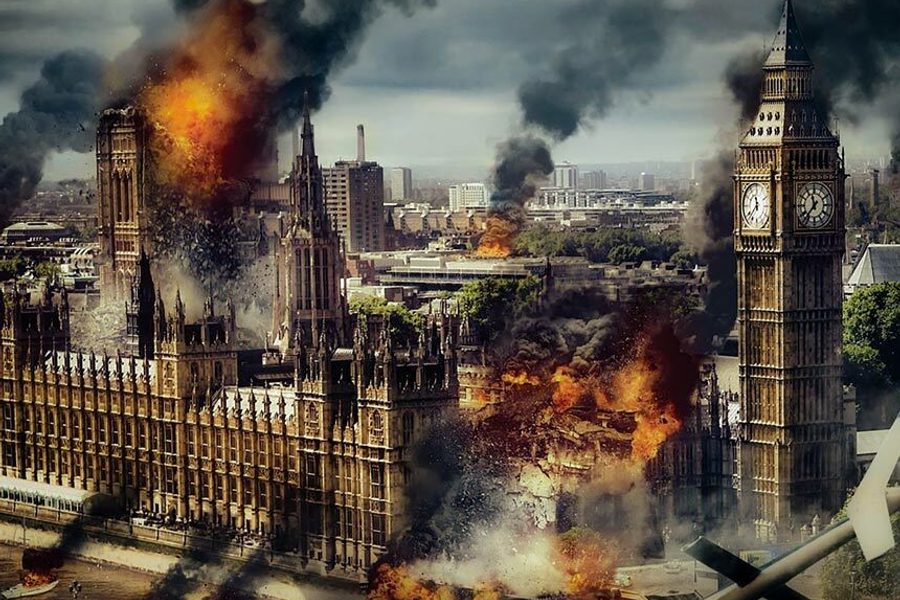‘London Has Fallen’ and the 9/11-ization of Entertainment
The sequel to ‘Olympus Has Fallen’ shows our ever-more-extravagant taste for destruction
Michael Atkinson

So here comes London Has Fallen, another retread blockbuster promising new and glorious visions of stalwart urban landmarks blown to smithereens. What fun. In terms of spectacle, this has become the new matinee paradigm: skyscrapers old and new atomized by wholesale cataclysm, immense clouds of cement dust (of a kind movies weren’t terribly familiar with before 2001), buildings losing their center tensions and keeling over in slow motion, the ensuing debris raining Pompeii-like onto narrow city streets. More buildings and dust and hellfire and crushing’s, cars mashed and stomped, tipped building-halves colliding with other buildings and grinding them into storms of granulated detritus, over and over again.
For an entire generation of mainstream moviegoers — at least, the two billion born since the release of Independence Day (1996) — the digitized extravaganza of urban catastrophe has become the main course of movie going, the defining principle of cinematic “excitement.” Like anyone whose love for tequila straight has erased any possible fondness for wine coolers, this generation is fully acclimated to the sensationalism of disaster, unimpressed by anything less alarming.
Cataloging the causes of this condition would be a dire task, from The Day After Tomorrow (2004) through the endless Avengers, X-Men, Dark Knight and Superman franchises and reboots, and including War of the Worlds (2005), King Kong (2005), all Transformers films (2007−2014 and beyond), Hancock (2008), 2012 (2009), the recent Terminator sequels (2009, 2015), Mission: Impossible- Ghost Protocol (2011), Pacific Rim (2013), Star Trek Into Darkness (2013), World War Z (2013), Oblivion (2013), Godzilla (2014), San Andreas (2015), Jurassic World (2015) and so on.
Used to be, Godzilla would stomp on a matchstick city and we’d grin at the spectacular toyness of the whole thing. Today, computer-generated imagery makes crystalline reproductions of such calamities affordable, and 9/11 gave the industry an eloquent object lesson in how to master the details. Spectacle filmmakers know like never before how exactly such catastrophe might play out (much bigger cement dust clouds, a clearer sense of how buildings fall in on their own hollow internal spaces, a keener notion of the weight and velocity of pulverized building materials, etc.).
It’s a queasy exploitation of the event, turning us all into perpetual rubberneckers, gawking from a helicopter distance. If we’re on the street, we see whatever destruction transpires in fragments, sliced by the view offered by the urban grid; the debris clouds explode out of side streets and come for us. It’s the 9/11-ization of entertainment, scaled and paced to duplicate the falling of the Twin Towers.
Just as in forms of real “spectacle violence” like jihad videos, the human cost of the destruction on the screen is not a salient issue, for the film or the spectator. The victims are faceless and unimportant; only the viewer is significant. Today, we channel almost all of our experience, conveniently and defensively, through screen devices, big and small, reducing it all, however real or unreal, to images and bite-sized text. Simultaneously, the sheer unreality of “reality” has become our world’s reigning principle, from CGI to reality shows, digital facelifts, Photoshop, embedded reporting, staged news events, social media hoaxes, news-as-advertising, product-placement-as-ordinary life, truth-twisting documentaries, fact-inventing political campaigns, ad infinitum.
The effect is that our innocence is lost: Like everything else, images of colossal destruction are entertainment now. Should we be worried that it doesn’t disturb us? Close your eyes and try to imagine how much less thrilling fun the destruction of The Avengers or Man of Steel or San Andreas would be if we knew it wasn’t all just happening on a hard drive, but staged with real materials in some way in the three-dimensional world. To at least some degree, we’d feel the shiver of a primal wrong, the chill we felt on 9/11. It’s as if the only way we as a culture could understand and assimilate 9/11 was by packaging it as impact-free entertainment, and watching it over and over again. We surrender our intimacy with suffering, and become slaves to the spectacle.









